

So often, men become accustomed to only wearing hats in the colder months. We love hiding under a beanie in winter, but we shouldn't shy away from men's summer hats. They are a great way to add an additional finish to an ensemble, either with a dash of sprezzatura within a suited look or as part of a more casual outfit.
Let's also not forget the medical benefits wearing headwear can have. UV rays from the sun can hurt us. By choosing a summer hat, sunglasses, and sunblock, men are helping to prevent the damage it can cause.
Although since the 1970s, the use of hats by men has reduced dramatically, there has been a resurgence over recent years, so to give you a clearer picture, we have broken down five key styles for you to try.
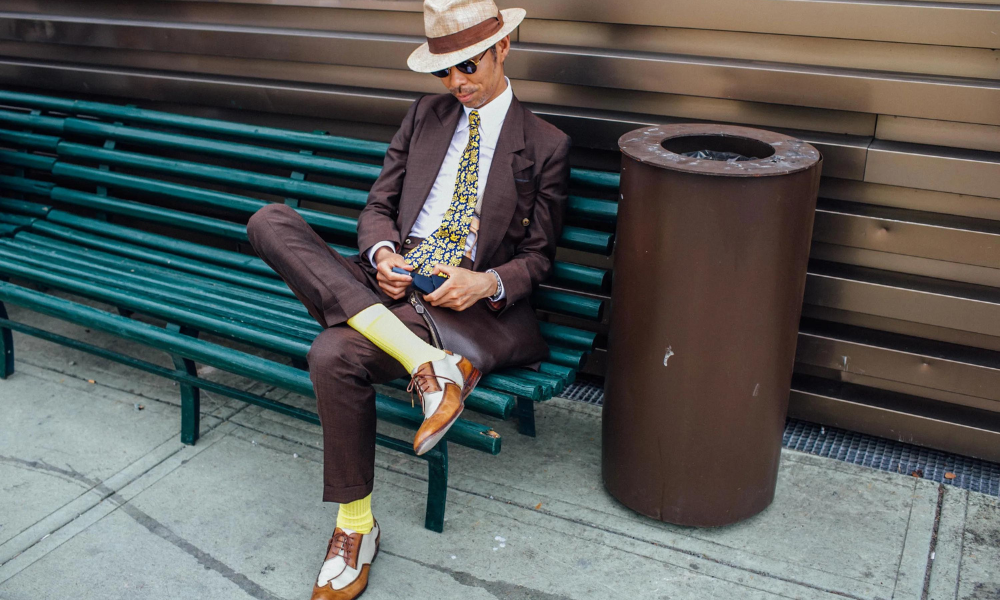
The trilby has an angled, narrow brim, slightly turned up at the back. Its name comes from the 1894 novel 'Trilby' when a hat of this style was worn during a play production of the novel.
The hat's popularity peaked in the 1960s and stirred up images in my mind of hazy days of tanned men smoking cigars. But its practicality when being worn in automobiles over higher hats was the real reason for its mass appeal.
Nowadays, the trilby evokes a sense of Riviera chic; this men's summer hat should take its lead from this aesthetic. Why not pair it with tailored trousers and a relaxed polo shirt for evening drinks on holiday?
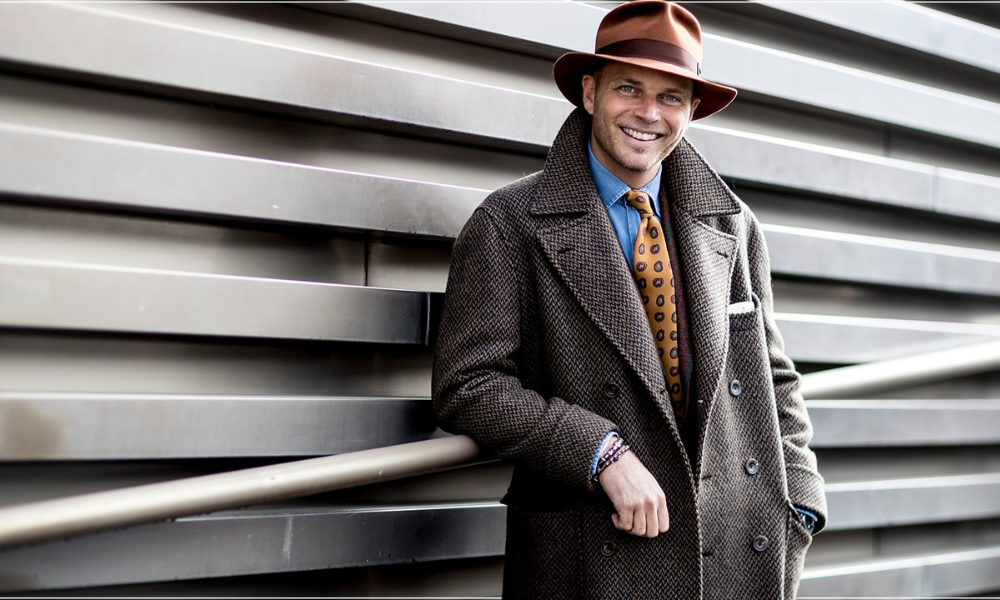
Even though it is similar to the trilby, the fedora has a wider brim. With its pinched sides, it is creased lengthways down the crown. Like the trilby, its name comes from the play 'Fedora', during which one of the main protagonists wears a soft-brimmed hat with a centre crease. Its popularity grew rapidly after Prince Edward wore the hat in 1924, coinciding with the rise of Prohibition and US gangsters who also favoured the hat style.
The brim of a men's fedora can be bent up or down, offering the wearer more flexibility and, as such, leading to more adaption from the wider public. Go for all-out tailoring to get the most from this summer headwear.

The baseball cap can get a bad rep in the menswear space. But, if we use it as a blank canvas, it can be utilised in any number of summer outfits. Firstly, it need not show your admiration for a given sporting team. We want it palpable, which means if you are unsure, your basic plain option. With less height and structure than a sports hat, this will lean into the worker look, making it a great partner for an overshirt or shacket. A simple, restrained approach is key with a summer baseball cap.
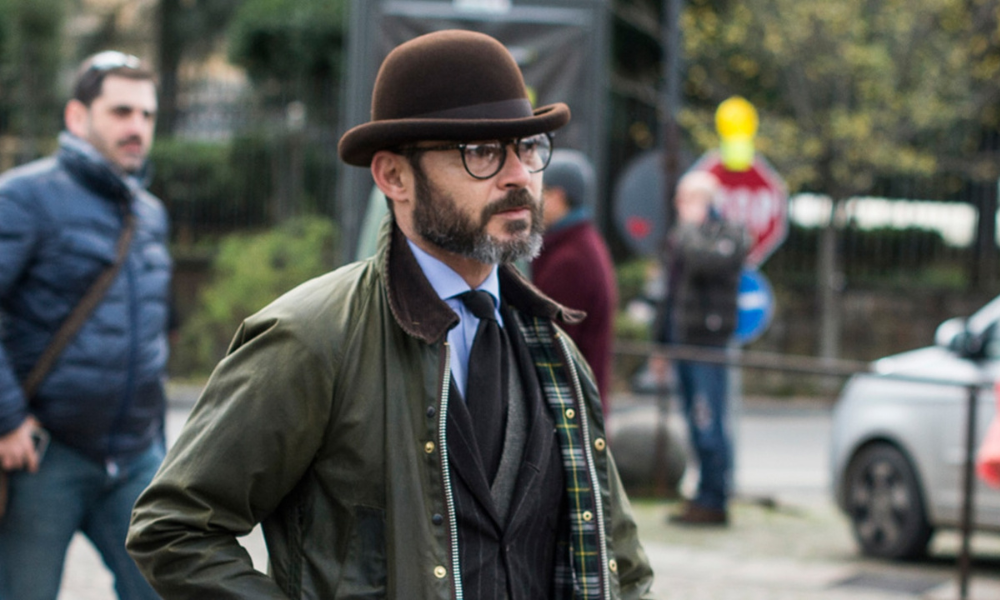
A much more formal men's summer hat style, it has connotations with the banking industry in the UK and stuffy executives pairing the hat with their pinstripe suits. It was initially designed in 1849 by the hat makers William and Thomas Bowler to fulfil a commissioned order for a hat that would protect gamekeepers' heads on horseback from tree branches.
The bowler hat has a stiff, rounded dome and a short, curled brim. Other names for this style include the bob hat, billycock, bombing or the more familiar derby.
We have to say, it takes a certain gent to be able to utilise this hat style in their daily arsenal. But, if you are daring enough, it could be a winner.
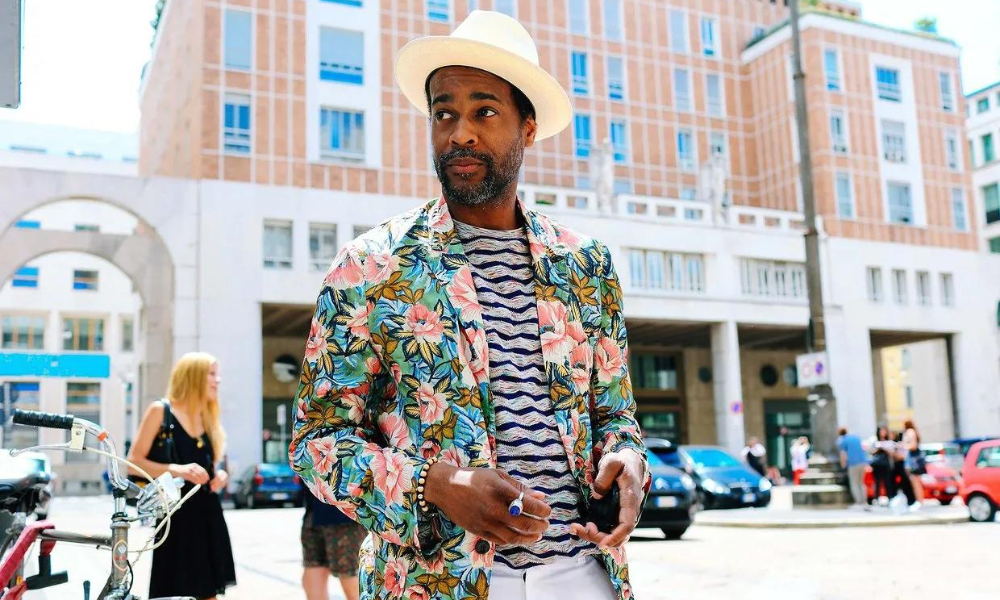
You would be mistaken if you thought the hat style came from Panama. They were originally made in Ecuador and shipped to Panama for sailors and those working on the Panama Canal.
Made from woven palm leaves, the shape is similar in size to a fedora with the same down in front, curled at the back features of a trilby. It is a slightly less formal option than its complimentary cousins. Its flexible weave can withstand many soakings, making it suitable for tropical climates.
Having a body shape that doesn't fit into the generic "norm" of brand sizing can be difficult. As a result, men with a slim figure will find it hard to buy clothes that flatter. Though, there are some useful styling and buying tips that skinnier guys can use to purchase the right clothes.
As we know, fit is everything when looking our best. So, read on for the guide on dressing for a slim figure. These style tips will be your bible for your next shopping trip. But we also want it to give men knowledge and confidence to alter the clothes they already own to show themselves in a more stylish and presentable light.
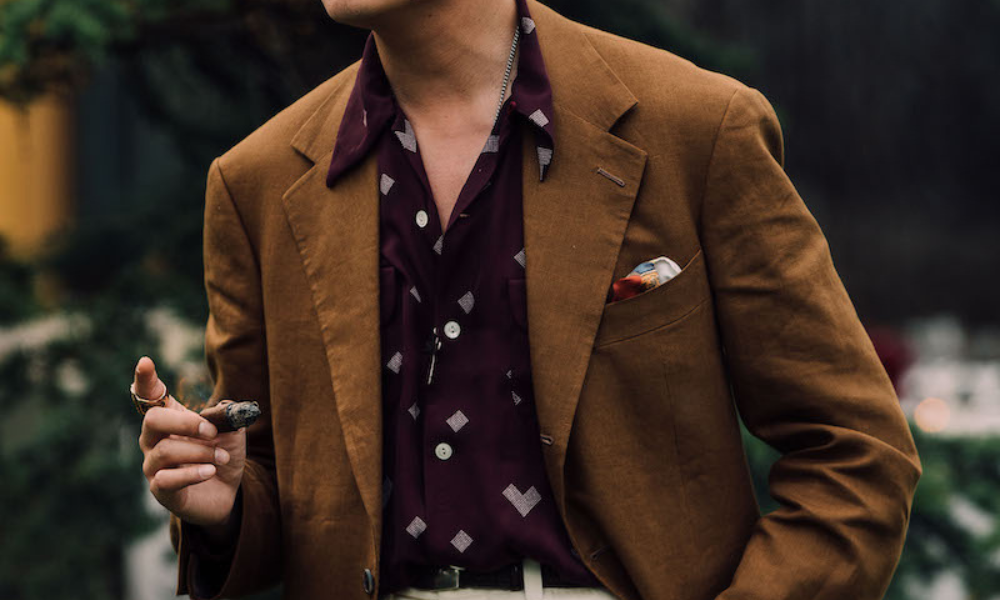
When a man has a slim upper or lower body shape, patterns or colours can be used as an optical illusion to make those areas look larger than they are.
Navy and darker-wash blue trousers are a notable way men can ground the bottom half of their outfits and deliver some hidden bulk. While on top, patterns can create depth. Either on their own or beneath a suit, a bold shirt or patterned polo shirt is a sartorial nod to slimmer dressing.
We have mentioned before on these pages how horizontal or vertical stripes can be menswear friend or foe. In this instance, horizontal stripes can elongate the body so we recommend sticking to vertical if possible.
It could be written on our gravestone. We are always preaching the importance of fit when choosing men’s clothing. Removing oversized products from a slim-figured man’s wardrobe is key, but don’t be coerced into going too far in the opposite direction and picking up skinny-fit pieces.
The skinny fit is a curse on modern menswear and will only make a slim man look even thinner. So, avoid it at all costs.
Slim-fit or even regular-fit (dependent on the brand) will strike that balance between a narrower silhouette and enough movement not to look tight.
Yes, having the right hairstyle can make a great difference.
Not always, but many slimmer men tend to have an angular face shape. Speak to a good barber who can use this shape to your advantage. A hairstyle that accentuates cheekbones or a strong jawline is preferred.
A great haircut not only gives a polished exterior but can also attract the eye. Drawing the eye like this moves focus away from the body. So, don't hide beneath a mop of hair, as the contrast in bulk will make the face look slimmer.
Find a great barber, as they are worth their weight in gold.

This will be a key part of your arsenal. By adding complimenting layers, men instantly add bulk without losing style points. Options like knitwear under a suit jacket or a vest poking through an open-neck shirt will give the illusion of depth and fool the eyes into thinking the body is bigger.
Another useful tip, if you are struggling with layering, is to take note of another of our points by introducing patterns. A simple check or herringbone pattern can add interest and the needed depth. But, men can also get a similar effect with texture. Different fabrics, especially in cooler months, like tweed, mohair or lambswool can deliver a layer with more textured appeal.
If you want to experiment with colours or patterns, we suggest keeping the solid colours for the outer layers and using checks or patterns beneath.
A double-breasted suit or blazer is an excellent piece for slimmer man to have in their wardrobe. Picking items like this that have structure will immediately enhance the upper half of your body.
The power play in formal dressing, a double-breasted jacket doesn't have to look out of place at work if you take note of some contemporary style tips. Wearing a T-shirt underneath and even trainers on foot can be a great way to break up the formality and make this suit style more every day.
Just remember that the double-breasted jacket can easily have the opposite effect if the fit is wrong. Due to the added fabric, if the fit is too loose, the style will swallow men with a slim figure and make it look like they have borrowed it from their dad.
Summer is ideal for reflecting on and expanding your daily footwear choices. Winter and summer are at opposites of the sartorial scale when we consider what we need from our footwear. So, a new season creates an optimum time to reflect on the shoes we own and where we are missing core options.
Winter is about braving the elements with robust materials and sturdy soles. That means a chunky grip for icy pavements and thick leather to stop the cold. But as soon as summer comes, our feet cry out for more ventilation. Most footwear will not see you through both winter and summer. Typical leather dress shoes like brogues or oxfords will look nice, but your poor toes will be overheated and smelling worse.
This guide will cover the essential men's footwear you need to be looking at and how to style them correctly.
Read on to discover our favourite summer shoe styles for men.

Whether you refer to them as white trainers or sneakers, there is no doubting their place in the list of summer footwear essentials. Keep them clean and crisp, and they will be the epitome of understated style. The versatile white trainer can blow away the formality of a suit or partner perfectly with jeans or chinos for casual weekend vibes.
The list is endless for men thinking of how to style their white trainers. They will literally go with anything. We prefer to keep an element of smartness and wear a nice fitting pair of suit trousers and a polo shirt.
But, equally, you can partner with shorts and a linen shirt for something more smart casual.
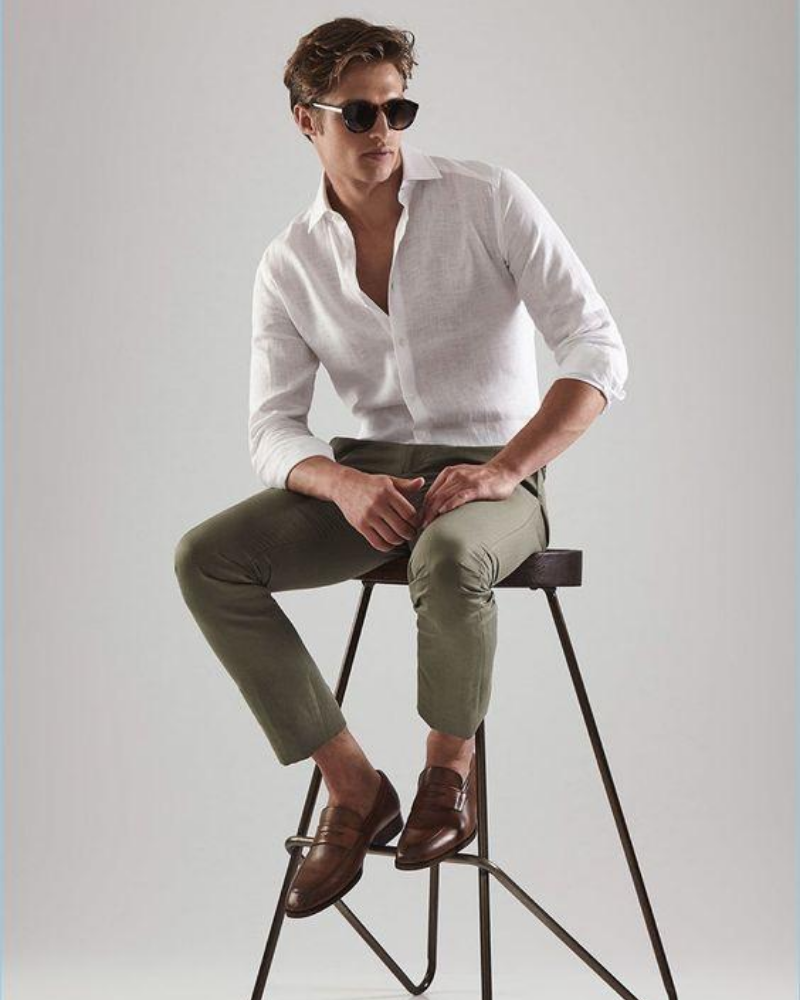
A leather penny loafer is a superb slip-on shoe for work that will offer better ventilation than a lace-up whilst retaining an air of formality. The classic penny loafer in a suede material can also provide a smart casual bridge between the office and the beer garden.
When styling loafers, the biggest faux-pas is having your trousers hanging over the shoe. Men want their trousers to have no break so as to make the whole shoe visible.
Take note; suede shoes absorb more sweat than leather. Avoid stinking out every room by picking up a pair of invisible socks.
Penny loafers deserve to be worn as part of smart attire. Feel free to loosen it up by removing the tie. Stick with the formal trousers, though, as the fit aligns well with the ankle-grazing length.
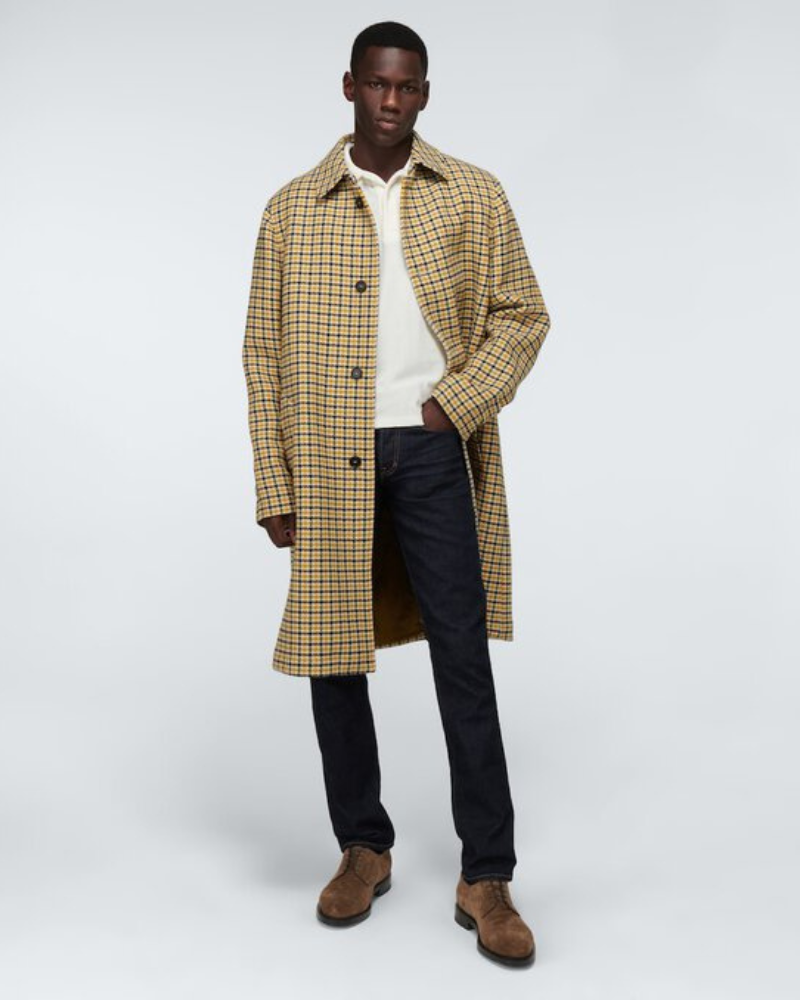
We can't all be blessed with spending our summer on the beach or in the beer garden. Sometimes we have to go to the office or have a wedding to attend. This is where the suede derby steps in. Like a relaxed version of the men's Oxford shoe, they will see you through any formal occasion this summer.
When looking at styles, focus on lighter colours like beige or tan. These colours can pair better with more warm-weather clothing you might already have.
As with all suede, we recommend sticking to a routine for keeping them in their best condition. Tools like a suede protector and brush should be in your shoe care kit if they aren't already.
We will stick with our previously mentioned colour palette for how to style them. Using a lighter tone can mean partnering with more summery colours like pastels or beiges to create a neutral, paired-back summer wedding outfit.

Synonymous with summer dressing, the espadrille has cut its teeth in warmer climates. Offering a casual twist on warm-weather footwear, the materials used to craft this shoe style deliver everything a guy needs in the summer. Breathable on top, the espadrille has a soft, woven sole, ideal for letting air circulate.
Lean into the relaxed Mediterranean aesthetic by picking fitted shorts with these shoes. Think beach-to-bar and ensure the top you wear with the shorts has all those laidback holiday vibes.
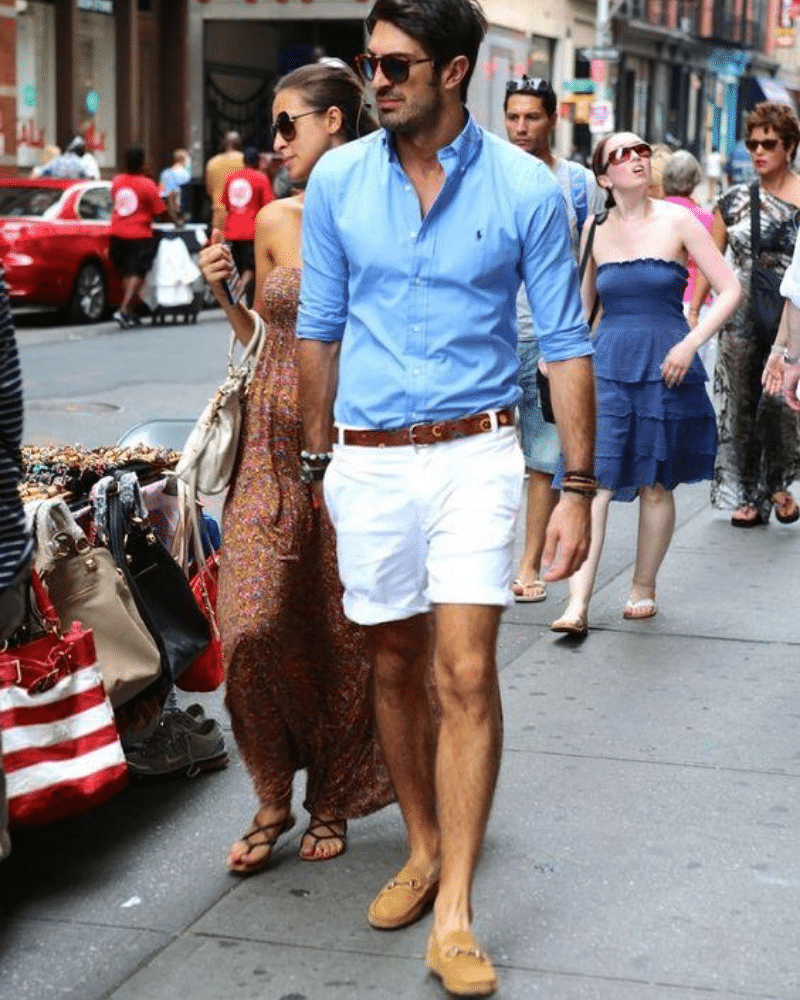
Another twist on the smart-casual loafer is the men's driving shoe. As you can expect from its name, there is an automotive history; a studded sole was added to make you feel the pedals better. Now it is a firm favourite among the summer wardrobes of most stylish men, whether they are driving the coastlines of southern France or not.
This moccasin-style shoe comes in a leather or suede construction and should never be worn with socks showing.
It is a flexible piece of footwear that can easily be worn with a suit as it could with chinos. We like to take a nod from the Riviera style book and pair driving shoes with a flattering pair of shorts and a shirt.
Summer, we can be honest, typically creeps up on us men. One day we proudly wear our cashmere jumper and mac, and the next, we are met with sweaty armpits on the commute to work. It doesn't have to be that way, and it is all about how we prepare for this notoriously difficult sartorial time of the year. Shorts are the answer for men looking exasperated at their summer (or lack of) wardrobe.
A versatile menswear piece, shorts come in all shapes and sizes, making them ideal for anything from hitting the beach to hitting the city bar. The key is to understand what shorts are most flattering for you and will integrate with your wider outfit choices. Thankfully, we are here to guide you through so you know which shorts to buy.
Before diving into specific shorts styles, let's cover some important buying considerations. When selecting the perfect pair of shorts, you should keep a few key things in mind.
Length
Shorts come in various lengths, from knee-length to thigh-amplifying short shorts. Every year the experts will tell you a different length to be wearing. However, for most men, the most flattering length will be from the knee to mid-thigh. This is your safe space.
Fit
No man should be showing the world what they were born with. Leave something to the imagination and ensure your shorts leave you some room. You should be able to get your finger comfortably around the hem and the waist. Being too restricted will only cause you to be more uncomfortable in hot weather.
Material
The material of your shorts can make all the difference in looks and comfort. Cotton is lightweight, breathable, and a good option for summer, while polyester is more durable and can handle more wear and tear. If you don't mind a bit of creasing, linen or a linen mix can ideally be partnered with a button-down shirt.
Style
Lastly, consider the overall style of the shorts and how they fit into your wardrobe. Do you want shorts that are casual or formal? Do you want them to be plain or patterned? Answering these questions will help you make the right choice. We always recommend men buy clothing that will last. So, if you can't see yourself wearing it again in 12 months, is it worth it?
Next up, we will run through some of our favourite short styles here at AGR. Tapping into these key picks will ensure you are never caught short (excuse the pun) when the sun decides to make an appearance.
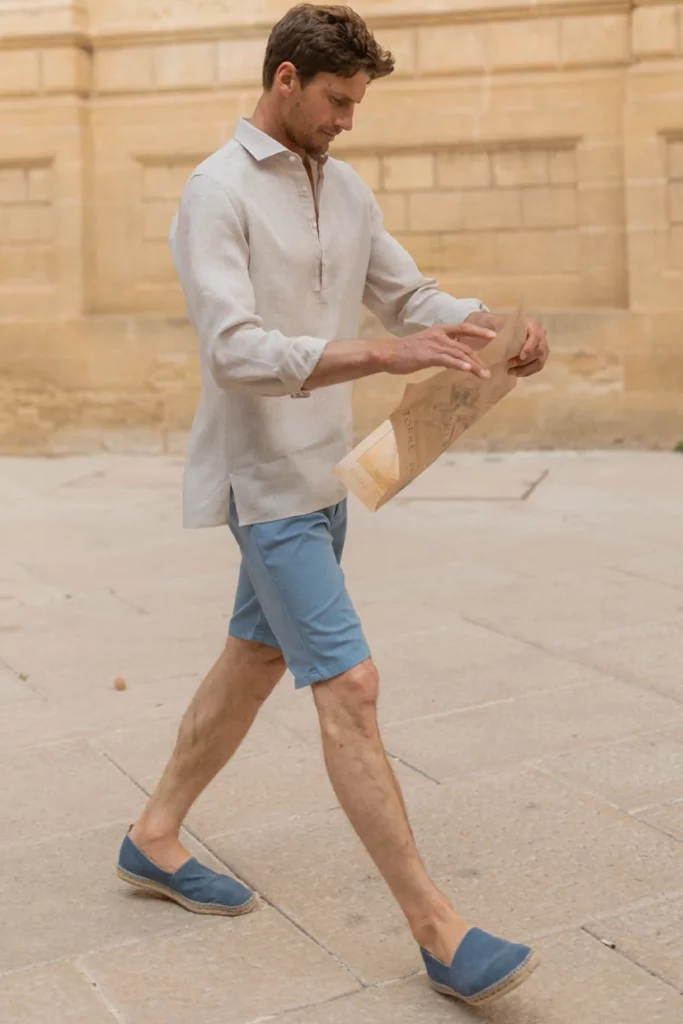
This is the staple pair men are most likely to have lurking in their wardrobes. Chino shorts are a dependable, simple choice that can cover various occasions due to their versatility.
A flat-front chino has an optimum hemline of about an inch above the knee. This length will ensure you get maximum wear as the easy-on-the-eye aesthetic and durable fabric could make these your daily favourites. When styling your chino shorts we like to wear them with a shirt and driving shoes for a smart casual look. But, equally, they can be worn with a simple tee for off-duty style.
Whichever way you rock them, the chino short is a timeless option that will have your back time and again. The fact that they come in every colour known to man, only adds to their allure.
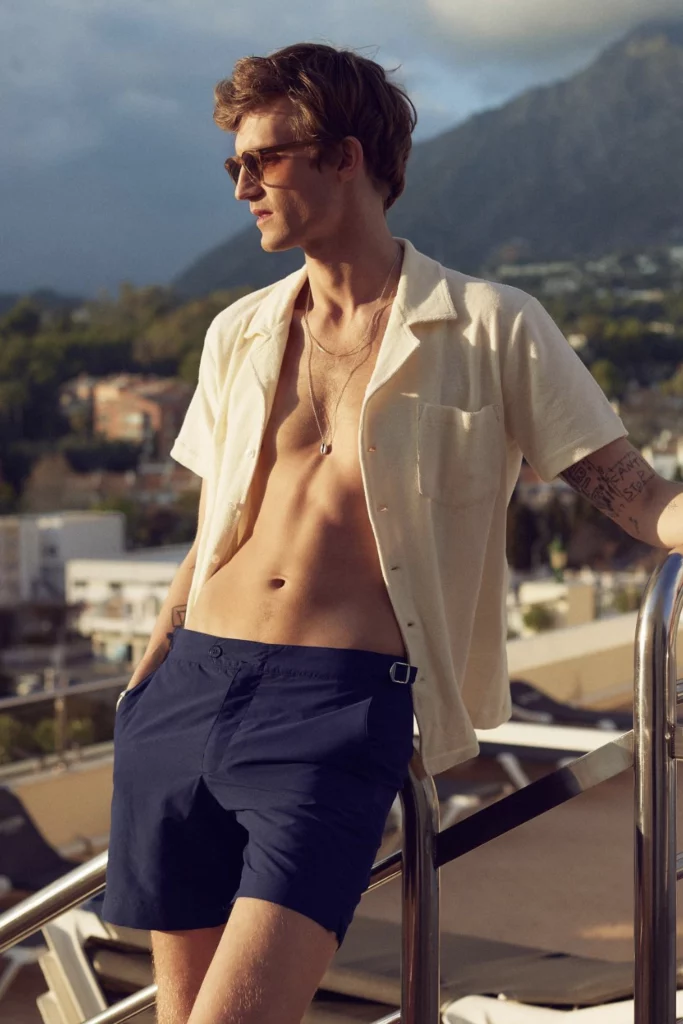
Burn your budgie smugglers and invest in a pair of great swimming shorts. There has been an explosion in resort wear over the past decade, and our holiday outfits are thankful for it. The sheer array of quality fabrics and head-turning designs mean the swimming short is no longer just for the water.
With quick-drying technology and tailored fits. Men can now feel comfortable wearing their swimming shorts from the pool to the bar. Just stick on a relaxed-fit linen shirt and some espadrilles, and you can skip a trip back to the hotel room.
When styling your shorts, remember it's a game of two halves. If you have chosen patterned swim shorts, muted tones on top would be preferred and vice-versa. Your only issue now is finding a pool in the city so you don't have to stop wearing them.
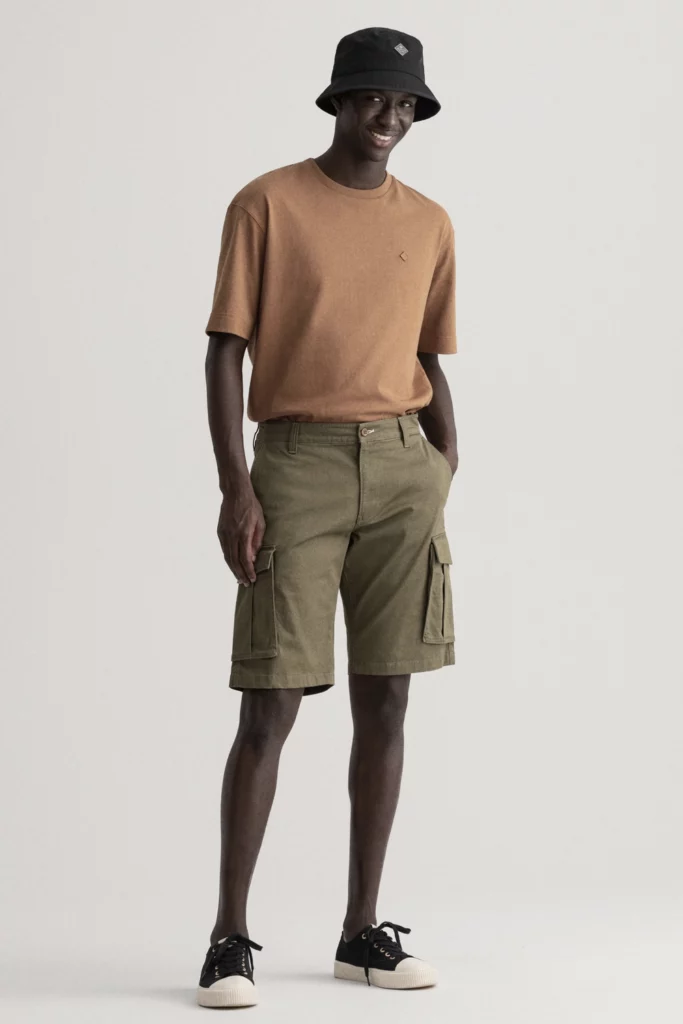
Once the uniform of choice for early-2000 teens, cargo shorts (and trousers) have seen a resurgence of late, with a more refined fit and smaller pockets. This updated version has been widely adopted and is now a strong option for a contemporary style of shorts.
The key to wearing cargo shorts, as with much of menswear, is about keeping it simple. As cargo shorts have quite a bit going on, patterned shirts or logo tees can be jarring. Clean, minimalist pieces like white trainers or a basic t-shirt will be less distracting and create a more cohesive look.
With a utilitarian aesthetic, it's not hard to see why cargo pants are so popular. They work in workwear or even streetwear outfits. Just remember, though, the pockets are for show. Keep your phone and wallet elsewhere, and for the love of god, no keychains.
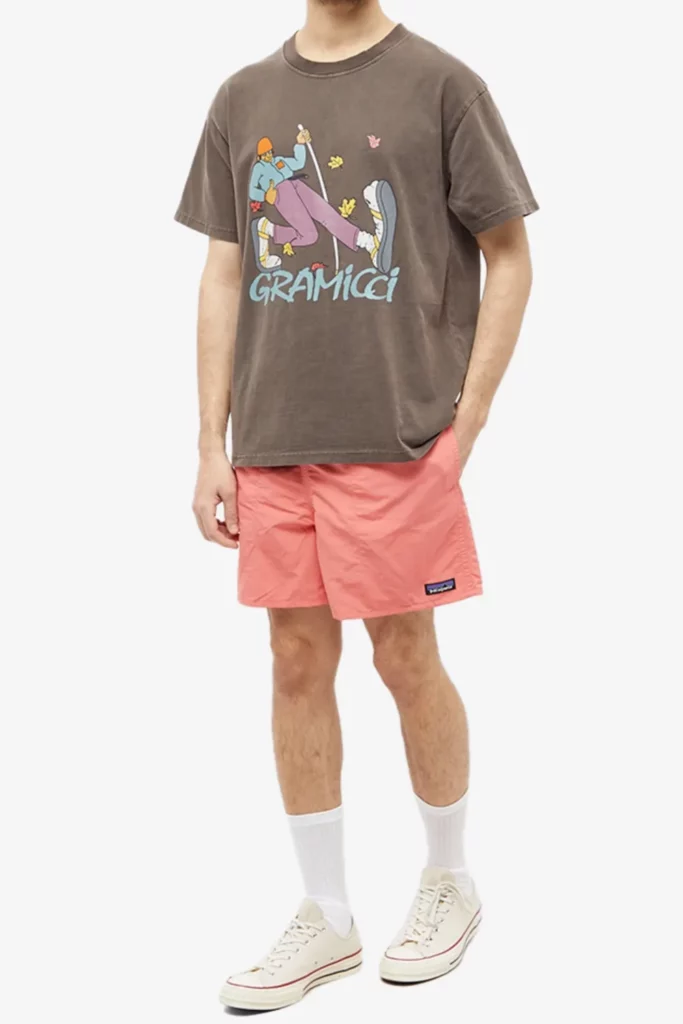
Shorts that nestle at the mid to upper thigh can be very flattering for those looking to show off a little more leg. They go by the moniker "short shorts" and can be difficult for most men to pull off. This length doesn't give you anywhere to escape. If you have consistently missed leg day, short shorts might be worth swerving. At the same time, those with large thighs are also recommended to move on to the next pick.
The resulting slither of men who would look great in this style now need to know what to wear with them. There are, of course, retro-inspired picks that pair nicely with trainers and a vintage tee. Though, we prefer a more understated pair of short shorts that can stick a linen shirt above and loafers beneath to nail some Mediterranean vibes.
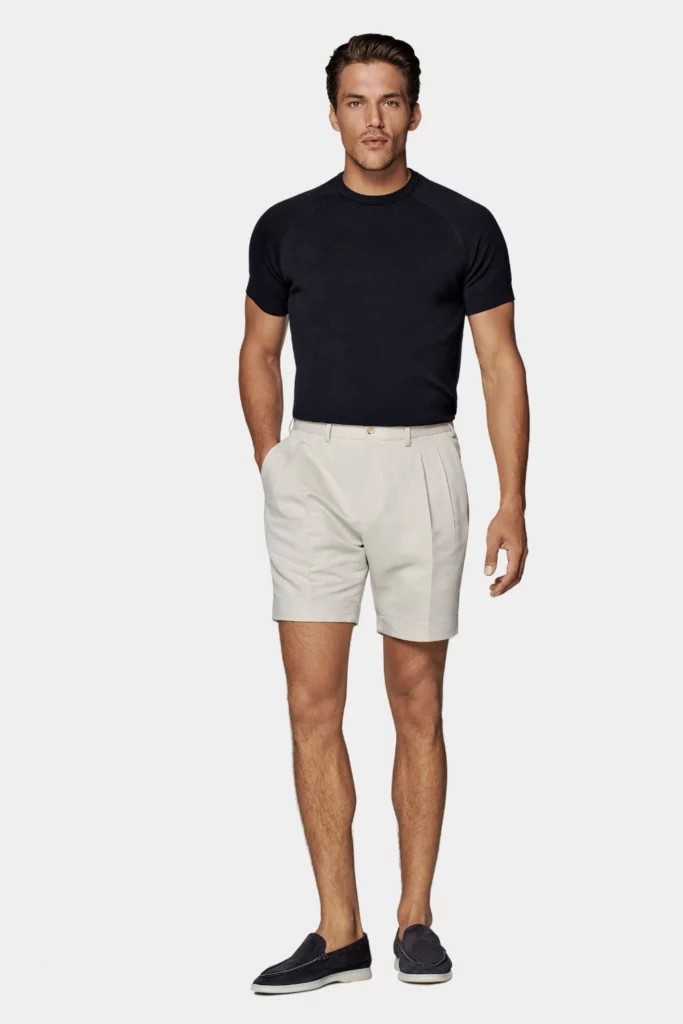
Though the chino can offer you an element of smartness, there is only one style that can truly lay claim to a formal option: tailored shorts. Similar to smart trousers in construction and material, the hem has risen above the knee to make them wardrobe fodder for the summer months.
It's crucial to get the fit right with these ones. A slouchy fit will look slobbish, which is not the desired outcome. To keep them presentable, choose a pair with a slim silhouette, allowing them to be worn with a formal shirt and smart shoes.
Adaptability is key to a modern man's wardrobe. We should approach tailored shorts in a similar vein. Yes, they are formal, but we have proven before on these pages that this shouldn't stop us from introducing casual elements. Like tailored trousers can be styled with a t-shirt and trainers, the shorts equivalent can also be. Taking the tailored shorts from their niche birthplace to a wider, more versatile home in your rotations.
A chameleon of smart casual dressing, a blazer is an essential piece of sartorial kit for men. It delivers a refined look that makes it a great choice for a mix of different dress codes, from your date night to a relaxed work vibe. Picking a more casual style will only expand your options further. This might mean losing some of the blazer's tailored aesthetic, but the result will be a key piece for spring, summer and beyond. In this article, we'll explore what a blazer is, the different types and materials available, and offer tips on how to wear and style this versatile item.
A blazer is a type of jacket with a rich history and has evolved over time to become a staple in many wardrobes today. Cast aside thoughts of splitting your suit and wearing the suit jacket independently. The blazer is clothing in its own right. Originally, rowing club members wore blazers in England in the 1800s. These jackets were made from heavy wool and featured bold stripes in the club's colours, and were worn with complimenting (not matching) trousers. Hence the difference with a suit jacket.
Over time, blazers became more popular outside of the rowing community and started to take on different styles and materials. Today, blazers come in various colours, patterns, and materials, making them a lynchpin of smart casual outfits.
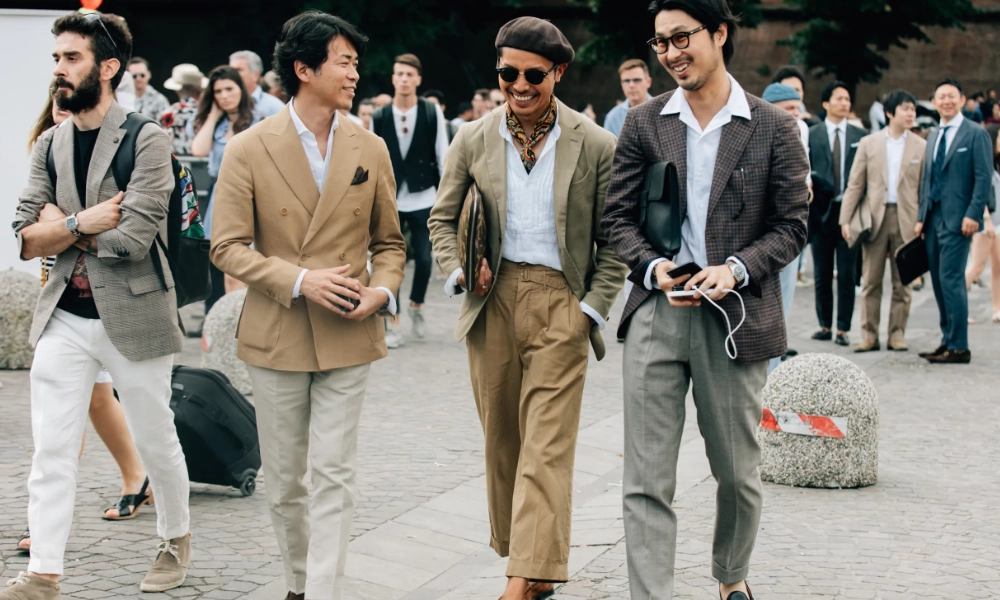
To save you any future sartorial embarrassment, we have included a list of key elements to remember when wearing a blazer.
An ill-fitting blazer will make you look slobbish. Pay close attention to how the blazer fits and drapes on the body. Different styles of blazers will present opposing outcomes, so find what works for your body shape.
A navy two-button blazer is a staple of a modern man's wardrobe. But that doesn't mean after you have ticked that off, men can't seek alternatives. Playing with patterns or fabrics can add interest and lift, giving your outfit a contemporary twist.
For the style uneducated, this can be a rookie error. Yes, tonally pairing colours on the top and bottom half can look great. However, it can be difficult to get right, so we recommend airing on the side of caution.
Some blazers, say a double-breasted number, are considered formal. Whereby an unlined two-button might be further along the scale towards casual. The former would work for a wedding invite but might be too much for a pint in the pub. Always have one eye on the occasion when planning an outfit.
What we mean by this is a bold tie, with pocket square and tie bar, will be overkill. Start with an understated pocket square. Sometimes, that might be all you need, and men should show restraint with accessories as they can easily ruin an outfit.

When choosing the right material for your casual blazer, there are many options to consider. Each material has unique qualities that can make a big difference in terms of comfort and style.
Cotton is popular for less formal blazers due to its breathability and comfort. It is a lightweight material perfect for warmer weather, making it a great choice for summer events or outdoor gatherings. It holds its shape well and doesn't take much effort to keep it presentable. Probably the most versatile blazer material, you can even partner with jeans and a t-shirt for a smart casual ensemble.
Another lightweight option for blazers is linen. This material is perfect for hot and humid weather, as it is highly breathable and allows air to circulate around the body. Linen blazers are also known for their relaxed and casual style, making them popular for beach weddings or outdoor parties. Keep the aesthetic loose when picking an outfit, and opt for less structured footwear like a loafer or white trainer.
Wool and wool blends are good picks for those looking for a heavier option. These materials are perfect for cooler weather, as they offer excellent insulation and can help keep you warm on chilly days. The material is thicker and more robust, making it durable and structured by nature. As such, they would work well with chinos or smart trousers.
There are a few styles to choose from when it comes to blazers. Single-breasted blazers are the most common and easiest to style. They are perfect for formal and casual occasions and can be dressed up or down depending on the occasion. These blazers typically have two or three buttons and a notch lapel.
Double-breasted blazers, on the other hand, are a little more formal and can add some extra flair to your outfit. They have two parallel buttons on the front, giving them a unique and stylish look. These blazers are perfect for weddings, business meetings, or other formal events. They usually have peak lapels, which add weight to their formal appearance.
Both a single or double-breasted blazer will come in lined or unlined versions. The more lining you have (think of it as padding), the more structured the blazer appears. Stucture makes the blazer look like a traditional suit jacket and therefore lends itself to formal occasions. That's why an unlined blazed is an ideal laidback casual choice that delivers pared-back tailoring.
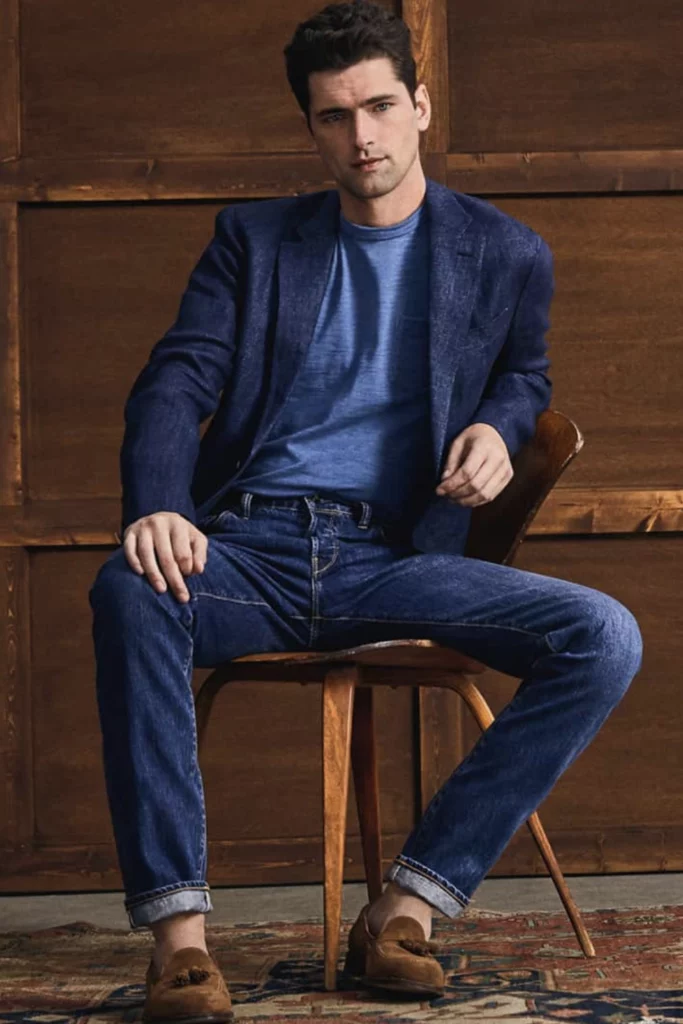
One of the most popular ways to wear a lightweight blazer is with jeans. Pair your blazer with dark-wash jeans and a plain t-shirt for a casual look. This effortless combination can take you from the office to a night out with friends.
The addition of the t-shirt gives the look a more contemporary feel, and this needs to travel down to the feet. A brogue of Oxford shoes could look jarring with the top half, which is why a suede loafer or even a minimalist trainer would be our pick.
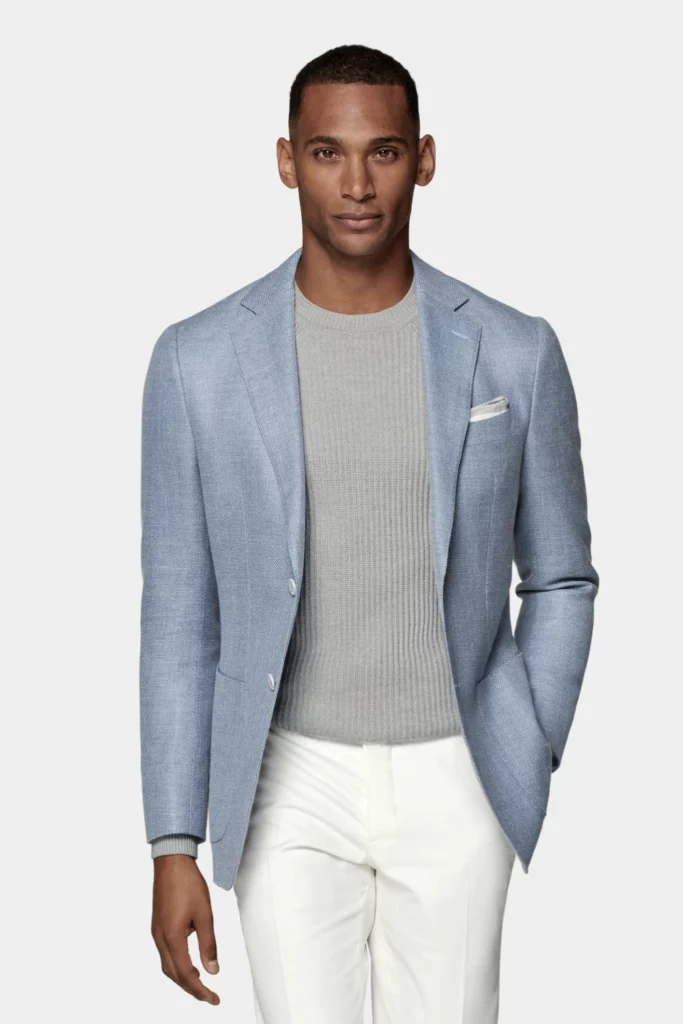
A classic combination, a navy blazer paired with cream trousers, is perfect for a less formal summer event. Though, men can use those same foundations to great effect. A light blue version, for example, says summer is here. At the same time, giving us more casual options underneath. Lightweight knitwear can easily be worn in place of a formal shirt, but both would work.
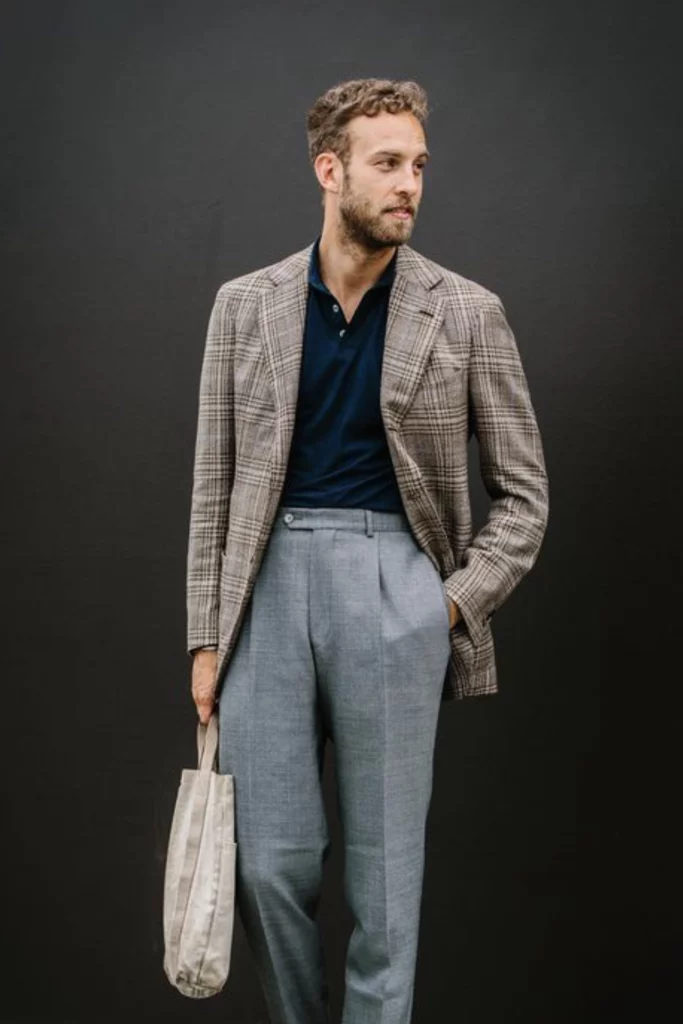
A polo shirt is a natural heir to the smart casual tailored throne, currently sat by the Oxford button-down. The polo shirt, when bought in a quality fabric like cashmere, merino wool or even a cotton blend offers a restrained casual element. Not as easygoing as the t-shirt it strikes a smart casual balance that is hard to beat.

In order to nail this look, gents need to carefully choose their blazers, t-shirt and trousers in a flattering, slim-line style. An oversized tee would look completely out of place, while well-fitted trousers like a chino help to create a unified silhouette.
On the feet, men can go full beach-bar holiday by wearing espadrilles or keep it more every day with a driving shoe or boat shoe.
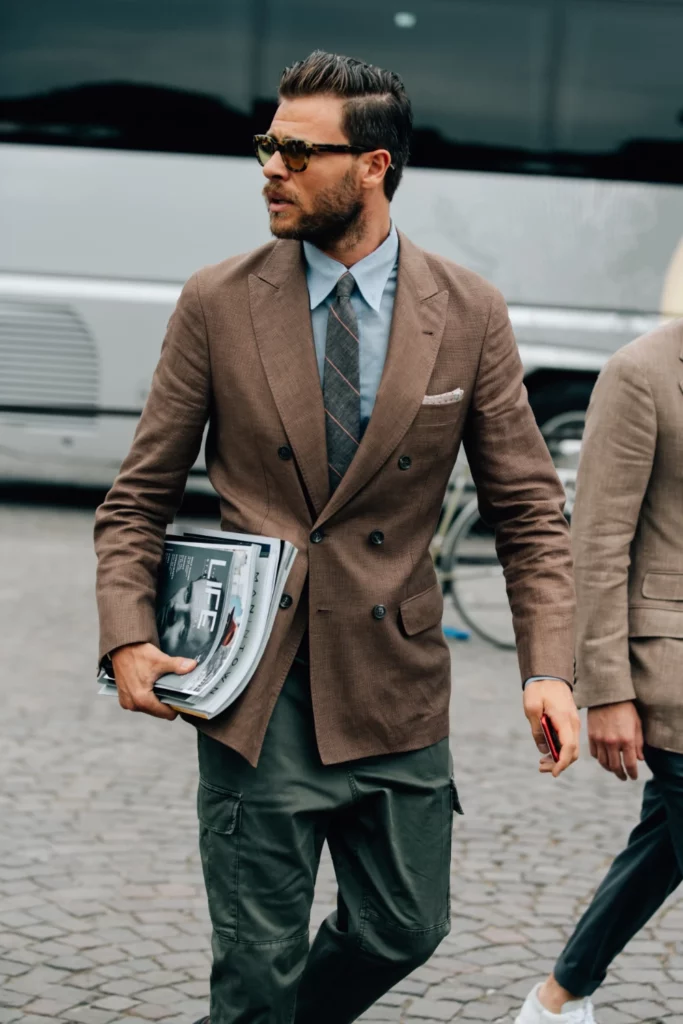
Some might faint at the idea of pairing these two polar opposites. But, the cargo trouser renaissance of late continues, and if you choose more refined options, it can work well with a blazer. We don't need to go as formal on top as the gentleman above. A simple polo shirt and blazer should suffice for a modern twist.
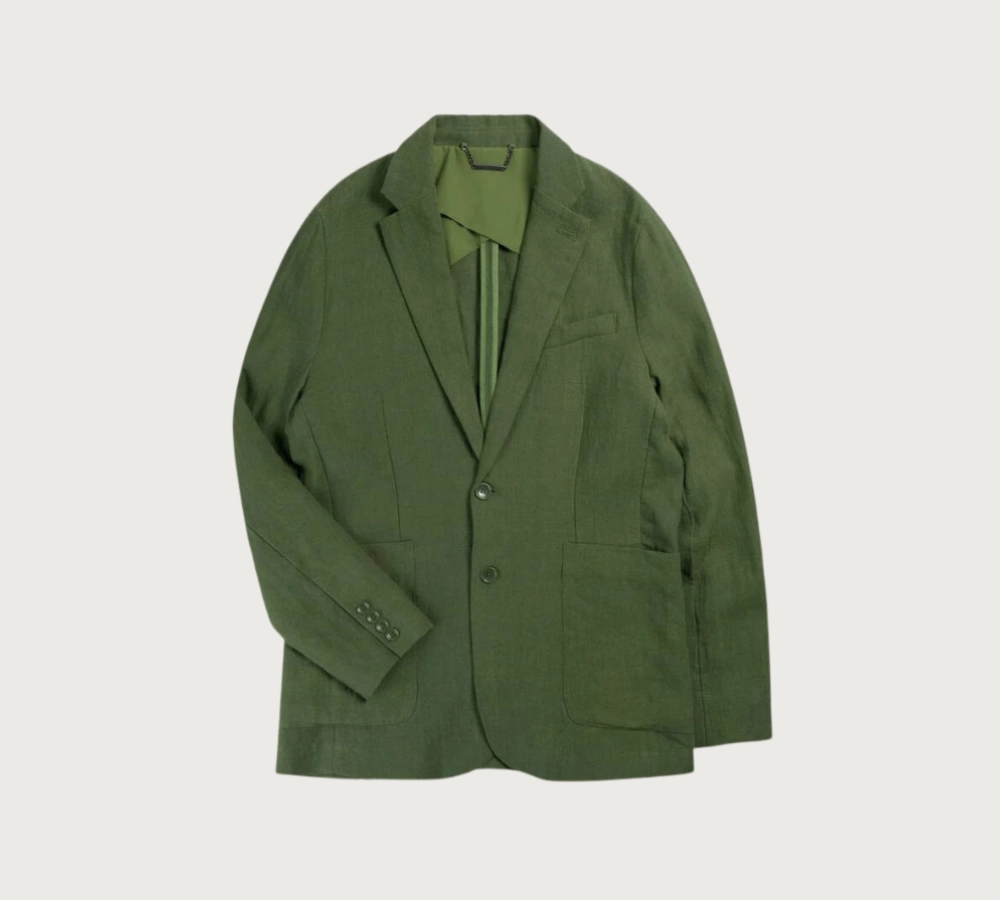
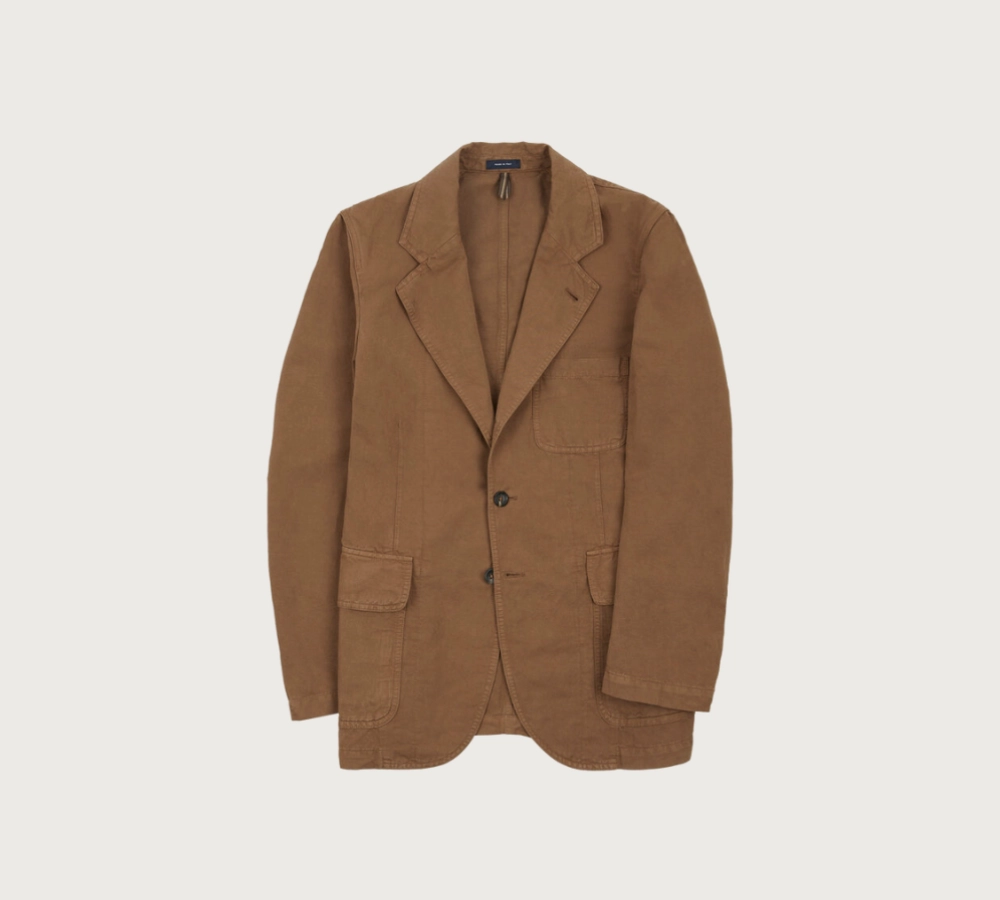
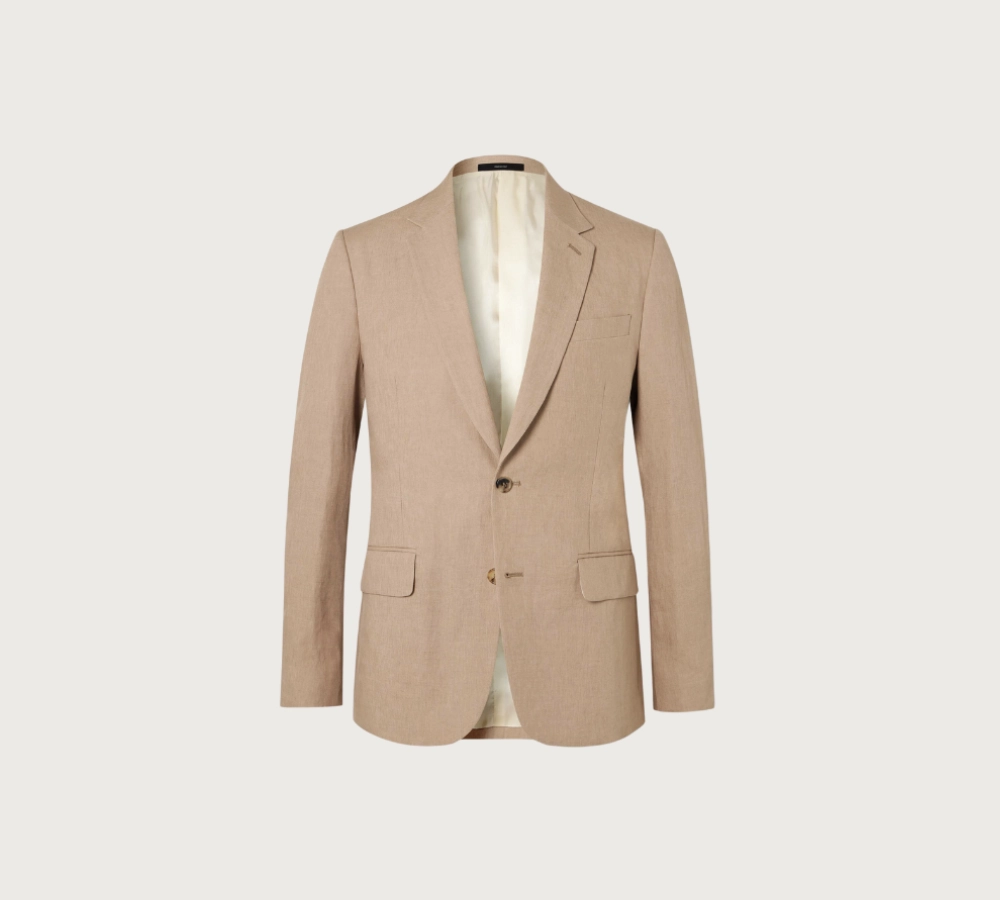
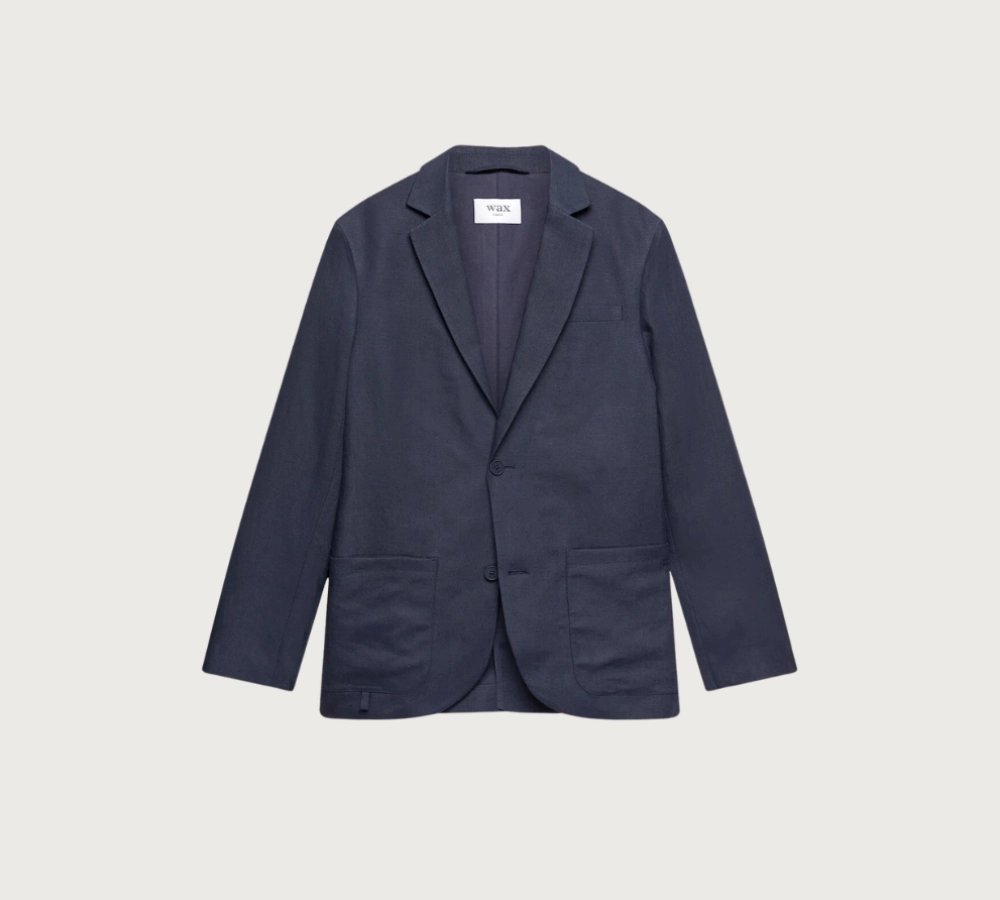

Bespoke shoes are the epitome of luxury footwear. They are tailored to the specific measurements and preferences of the wearer, resulting in a fit and style unmatched by mass-produced shoes. From the design process to the final product, bespoke shoemaking is a painstaking art that requires meticulous attention to detail.
Bespoke shoemaking has a rich and fascinating history that spans centuries. The earliest records of bespoke shoemaking date back to medieval Europe, where shoemakers were highly skilled artisans who crafted shoes by hand using traditional techniques.
During this time, bespoke shoemaking was considered a luxury reserved for the wealthy and elite. Shoemakers would work closely with their clients to create shoes that were not only functional but also stylish and fashionable. The shoes were made from high-quality materials such as leather, silk, and sheepskin and were crafted with incredible attention to detail.
Traditional bespoke shoemaking involves dozens of steps carefully executed by skilled artisans. The process begins with creating a wooden last; a foot-shaped mould used as a foundation for the shoe. The shoemaker then cuts and shapes the leather to fit the last before hand-stitching the seams and adding any decorative elements.
One of the most important aspects of bespoke shoemaking is using high-quality materials. Skilled shoemakers only use the finest materials, such as leather tanned using traditional methods, silk threads, and sheepskin linings. This ensures that the shoes are soft and supportive and incredibly durable, able to withstand years of wear and tear.
Despite the rise of mass-produced footwear during the Industrial Revolution, the demand for bespoke shoes continued to thrive. This was driven by those seeking superior craftsmanship, unique designs, and personalized fit that could not be found in mass-produced shoes.
In recent years, bespoke shoemaking has grown in popularity, spurred by a renewed interest in handmade craftsmanship, customization, and sustainability. Today, there are a growing number of modern bespoke shoemakers who combine traditional techniques with contemporary designs, catering to a diverse range of customers.
These modern shoemakers often use innovative materials and techniques, such as 3D printing and laser cutting, to create shoes that are not only beautiful but also comfortable and functional. They work closely with their clients to create shoes that are truly unique, taking into account factors such as foot shape, gait, and personal style.
Furthermore, many modern bespoke shoemakers are committed to sustainability, using eco-friendly materials and production methods to create beautiful and environmentally responsible shoes.
Overall, the history of bespoke shoemaking is a testament to the enduring appeal of handmade craftsmanship and the importance of quality materials and attention to detail. Whether traditional or modern, bespoke shoemaking continues to captivate and inspire people worldwide.
The bespoke shoe design process is a collaborative effort between the shoemaker and the client. It starts with an initial consultation, during which the shoemaker takes precise measurements of the client's feet and discusses their design preferences.
But the bespoke shoe design process is more than just taking measurements and selecting materials. It's a true partnership between the client and the shoemaker, with each party bringing their unique expertise. The shoemaker's knowledge of shoe construction and design is complemented by the client's understanding of their style and comfort needs. Together, they create a truly one-of-a-kind shoe.
During the initial consultation, the shoemaker will take the client's foot measurements, paying close attention to each foot's length, width, and arch height. They may also ask about the client's lifestyle and wardrobe preferences to create a shoe that fits their lifestyle and personal style.
For example, if the client spends much time on their feet, the shoemaker may recommend a design that provides extra support or cushioning. Or, if the client has a particular colour or texture in mind, the shoemaker can help them select the perfect leather to achieve their desired look.
Once the measurements are taken, clients can select the materials and styles they want for their bespoke shoes. Shoemakers typically offer a variety of leathers, from calf to exotic skins, as well as a range of colours and finishes. The client can also choose from various designs, including oxfords, brogues, and loafers, among others.
But the options don't stop there. Shoemakers can also incorporate unique details into the design, such as hand-painted patterns or intricate stitching. The possibilities are truly endless.
After selecting the materials and style, the shoemaker will work with the client to customize the shoe design for optimal comfort and aesthetics. This can include adjusting the shoe's fit, modifying the toe box's shape, or adding special details like personalized monograms or unique stitching patterns.
The shoemaker will also consider the client's foot shape and any specific comfort needs they may have. For example, if the client has a high arch, the shoemaker may add extra padding to the insole to provide additional support.
Overall, the bespoke shoe design process is a true collaboration between the client and the shoemaker. It's an opportunity to create a shoe that is beautiful and unique and perfectly tailored to the client's individual needs and preferences.

The last is a critical component in bespoke shoemaking, as it is the foundation for the shoe. It is a wooden mould shaped like the client's foot, made by hand from a wood block and adjusted throughout the design process.
To create a bespoke last, a skilled shoemaker will use a combination of hand tools, including knives, rasps, and sandpaper, to shape a block of wood into the desired shape. Hand-carving a wooden last is a true art form, requiring precision, skill, and patience.
The first step in creating a wooden last is accurately measuring the client's foot. These measurements are then used to create a rough outline of the last. From there, the shoemaker will use a combination of tools to shape the last, carefully carving away excess wood to create the perfect shape.
One of the most important aspects of hand-carving a wooden last is achieving the correct arch height. The arch of the foot plays a crucial role in the overall fit and comfort of the shoe, and a poorly designed last can lead to discomfort and even long-term foot problems.
The last is critical to the fit and comfort of the shoe, as it determines the shape and structure of the shoe's upper. In bespoke shoemaking, the last is created specifically for the client's foot, ensuring a perfect fit that cannot be achieved with off-the-shelf shoes.
Another important aspect of the last is its effect on the shoe's aesthetics. The shape of the last will determine the overall shape of the shoe, from the toe box to the heel. A well-designed last can create a beautiful, elegant shoe that complements the client's foot and style.
The last will be adjusted throughout the shoemaking process to ensure a perfect fit. The shoemaker will check the fit with each step, making adjustments as needed to ensure that the shoe conforms to the shape of the client's foot.
This process may involve adding or removing material from the last or reshaping it to achieve the desired fit. The shoemaker may also use padding or other materials to adjust the shoe's fit, ensuring that it is comfortable and supportive.
Overall, the art of last-making is a crucial component of bespoke shoemaking. A well-designed last can make all the difference in the fit, comfort, and aesthetics of a handmade shoe and is a testament to the skill and artistry of the shoemaker.
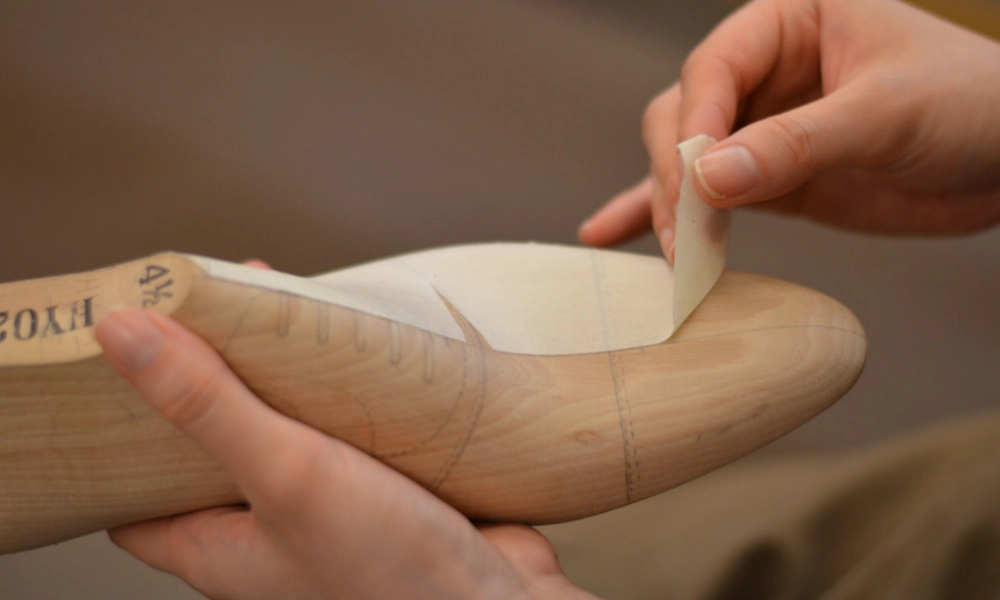
The upper part of the shoe encases the foot and provides support and protection. It is the most visible and customizable part of the shoe, and therefore, it requires the most attention to detail and precision.
The first step in crafting the upper is cutting and skiving the leather. The shoemaker will carefully select the leather, considering factors such as quality, texture, and color. They will then use precise measurements and cutting techniques to cut the leather into the desired shape. This process requires a steady hand and a keen eye for detail, as even the slightest mistake can affect the fit and appearance of the shoe.
After the leather is cut, the shoemaker may use a skiving knife to thin out certain areas of the leather. This technique creates a smoother finish and reduces bulk in areas where the leather overlaps or folds, such as the seams and edges. Skiving is a delicate process that requires a high level of skill and experience, as it can easily damage the leather if not done correctly.
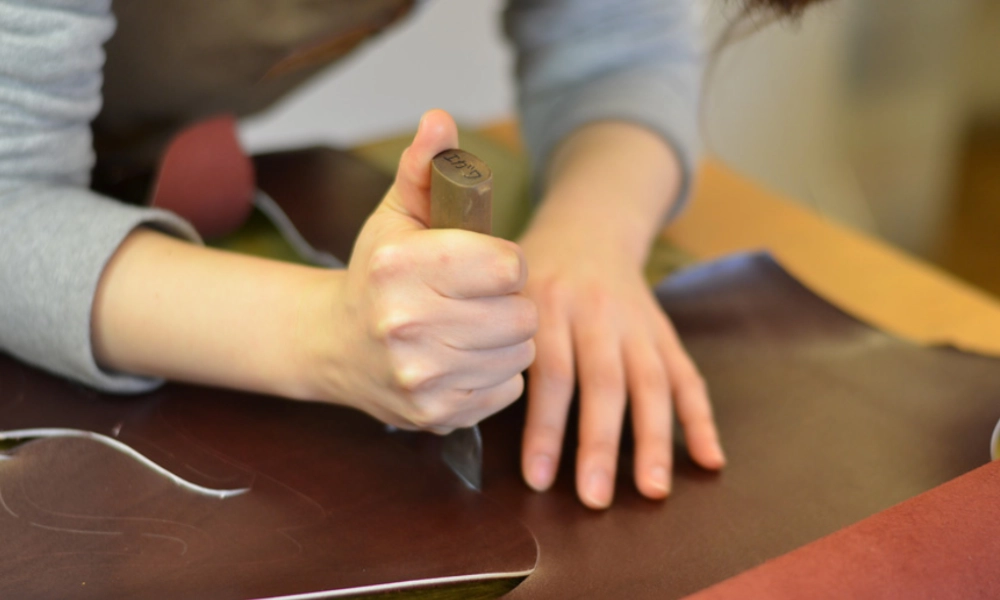
Once the leather is cut and prepared, the shoemaker will assemble the upper components. This involves stitching together the various leather pieces, including the vamp, quarters, and heel counter. The shoemaker may use various techniques, such as welt construction or hand-sewn welting, depending on the style and design of the shoe.
Welt construction involves attaching a strip of leather, known as the welt, to the upper and sole of the shoe. This technique provides added durability and support to the shoe and a distinctive aesthetic. On the other hand, hand-sewn welting involves stitching the upper and sole together by hand, using a needle and thread. This technique is time-consuming and requires a high level of skill, but it results in a comfortable and durable shoe.
After assembling the upper components, the shoemaker will move on to hand-stitching and detailing. This is where the shoe truly comes to life, as the shoemaker adds personalized touches and unique features.
The shoemaker will hand-stitch the upper to the sole, using various stitching techniques to create a secure and durable bond. They may also add decorative touches, such as contrasting stitching, decorative perforations, or customized hardware, to enhance the shoe's overall appearance.
In conclusion, bespoke shoemaking is a complex and demanding art that requires years of training and practice. But for those who appreciate the beauty and value of handmade craftsmanship, it is a true labour of love, resulting in shoes that are stylish, comfortable, durable, and timeless. Crafting the upper is just one part of the process, but it is a crucial step in creating a functional and beautiful shoe.